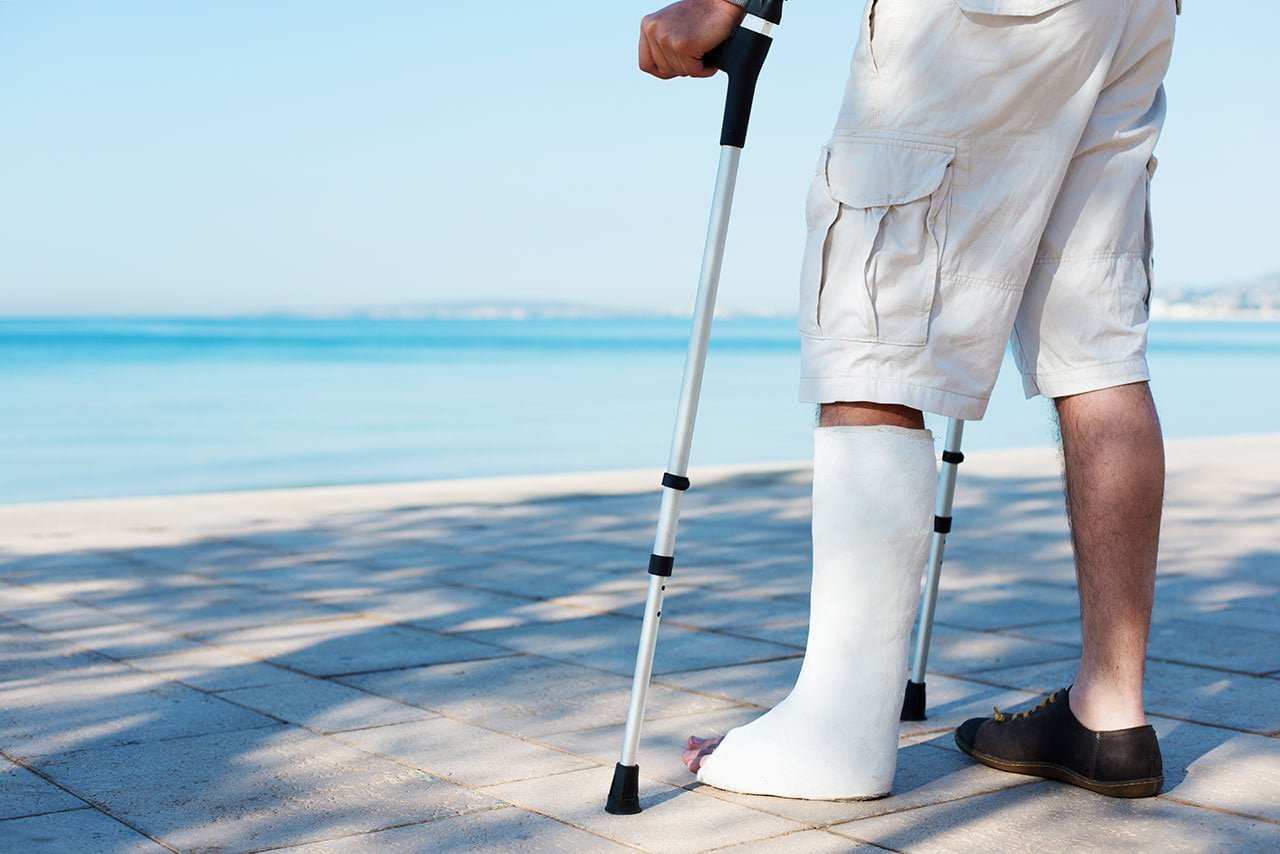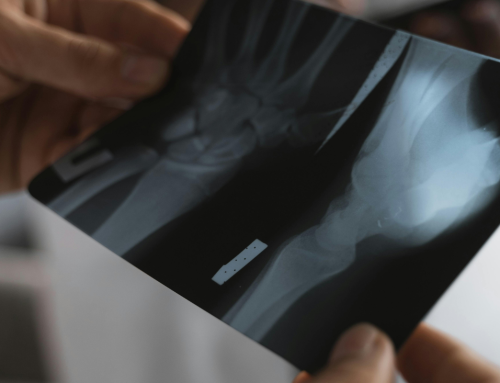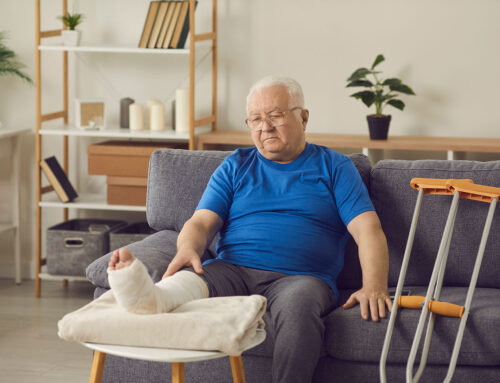Take control of your recovery timeline. In this guide, you’ll discover how to heal faster and avoid the complications that affect 1 in 5 fracture patients:
- The five stages of fracture healing—and the critical windows where intervention makes the biggest difference.
- How to avoid the setbacks that delay up to 20% of fractures and what warning signs to never ignore.
- The nutrition mistakes that can add time to your recovery (and the specific foods that accelerate healing).
- Why LIPUS therapy can reduce your healing time by up to 38% and who benefits most.
- Proven strategies to safely speed healing after experiencing a fracture.

Bottom Line: Bone healing follows multiple stages over 6-24 months, but 5-10% of fractures experience serious complications like delayed healing or non-union. Understanding what happens at each stage—and what can go wrong—gives you the power to take control of your recovery timeline.
The 5 Stages of Fracture Healing: Your Body’s Master Plan
Stage 1 – Emergency Response: Blood Clot Formation
Timeline: First few days after fracture
What’s Happening: Within minutes of your fracture, your body launches an emergency response. Blood vessels torn by the break flood the area, forming a protective blood clot (hematoma) around the fracture site. This is your body creating the foundation for everything that follows.
Why This Stage Matters: This blood clot is like construction scaffolding. Without proper clot formation, healing stalls before it even begins.
Warning Signs of Problems:
- Excessive swelling that doesn’t improve after 48-72 hours
- Signs of poor circulation (cold, blue, or numb extremities)
- Infection symptoms (increasing redness or warmth)
Critical Healing Success Factors:
- Proper immobilization immediately after injury
- Good blood circulation to the fracture site
- Following initial care instructions precisely
Stage 2 – Building the Bridge: Soft Callus Formation
Timeline: 1-3 weeks post-fracture
What’s Happening: A week or two after the fracture, your body’s cells begin to produce collagen, which forms a soft layer of cartilage—or callus—that bridges the fracture gap. This firm, rubbery scaffold provides the first real stability to the broken bone.
Why This Stage Matters: A strong callus means your fracture is stabilizing. A weak or incomplete callus leaves the bone unstable, increasing the risk of delays or failure to heal.
Warning Signs of Problems:
- Persistent swelling and pain without improvement
- The fracture feels unstable or “loose”
- No signs of callus formation on follow-up imaging
Critical Healing Success Factors:
- Adequate protein, vitamin C, and essential nutrients for bone healing to fuel tissue building
- Gentle, approved movement to promote circulation without stressing the fracture
- Strict adherence to immobilization protocols to protect the delicate callus
Note for high-risk patients: If you have risk factors like smoking or diabetes or are over 50, additional healing support options like LIPUS therapy can be highly beneficial.
Stage 3 – The Transformation: Hard Callus Formation
Timeline: 3-8 weeks (can extend to 12 weeks for complex fractures)
What’s Happening: The soft cartilage bridge is transformed into hard bone. This is the first real sign of lasting stability, as minerals like calcium and phosphate begin hardening the callus. This is typically the longest stage of healing.
Why This Stage Matters: This stage is your shift from fragile recovery to real strength. A solid, hard callus reduces your pain, restores stability, and protects against re-injury. If it’s weak, recovery slows dramatically.
Warning Signs of Problems:
- Sharp pain during light activity or normal movement
- X-rays showing little to no bone bridging after 6 weeks
- Increasing tenderness instead of improvement
Critical Healing Success Factors:
- Nutrient support: calcium, vitamin D, magnesium, and phosphorus
- Avoiding premature or excessive stress on the fracture
- Continued LIPUS therapy to accelerate mineralization and hard callus formation
- For patients experiencing delays or with complex fractures, LIPUS therapy has been shown to accelerate mineralization and hard callus formation by up to 38%.
Concerned about your healing progress? Learn more about LIPUS therapy →
Stage 4 – Getting Back to Life: Bone Strengthening
Timeline: 2-6 months post-fracture
What’s Happening: The initial repair bone matures into stronger, more organized bone. The fracture site becomes stronger and begins functioning more like normal bone, allowing a gradual return to daily activity.
Why This Stage Matters: In this stage, patients begin to feel better and resume normal activities. However, returning to full activity too early can set you back months. The bone is strong enough for light use but still maturing.
Warning Signs of Problems:
- Fracture line still visible after several months on X-rays
- Pain or instability with light activity
- Recovery progress stalls or reverses
Critical Healing Success Factors:
- Following physiotherapy and rehab exercises exactly as prescribed
- Maintaining consistent nutrition and hydration
- Gradual, progressive return to weight-bearing activities
What to do if healing is delayed: If you’re not progressing as expected by month 3-4, don’t wait. Delayed unions are much easier to treat than non-union fractures. LIPUS therapy shows particularly strong results in preventing delayed unions from becoming non-unions.
Stage 5 – The Final Chapter: Bone Remodeling
Timeline: 6 months to 2+ years
What’s Happening: Temporary woven bone is replaced with strong, organized bone. The fracture site reshapes to restore the bone’s original form and strength.
Why This Stage Matters: Remodeling determines whether your bone returns to full strength. Done right, you return stronger than before. Lingering weakness or limitations often trace back to incomplete remodeling.
Warning Signs of Problems:
- Chronic pain or tenderness beyond the expected healing window
- Limited mobility or stiffness that doesn’t improve with physical therapy
- Repeat fractures at or near the original site
Critical Healing Success Factors:
- Progressive, doctor-approved activity to stimulate bone adaptation
- Long-term nutrition support with calcium, vitamin D, and protein
- Continued adherence to physical therapy and movement protocols
Note: Ongoing use of LIPUS therapy can support remodeling and reduce lingering weakness, helping you regain your original strength faster.
What Slows Bone Healing: The Recovery Killers
Between 5-10% of fractures experience significant delays or non-union, with rates reaching up to 20% for high-risk cases like severe open fractures or patients with multiple risk factors. Understanding what derails recovery gives you the power to avoid these pitfalls. These three factors are within your control and have the most dramatic impact on healing outcomes:
1. Smoking/Nicotine Use
This is the single worst offender. Nicotine causes vasoconstriction, severely narrowing blood vessels and starving the fracture site of oxygen, blood, and nutrients. This increases the risk of non-union up to 4x in some studies.
What You Can Do: Stop smoking immediately. Even short-term cessation drastically improves local blood flow and increases the odds of successful healing. If you can’t quit entirely, work with your doctor on cessation aids. Even reducing nicotine intake helps.
2. Nutritional Deficiency
Bone repair demands sustained supplies of protein, calcium, vitamin D, and vitamin K2. Without adequate nutrition, your body cannibalizes existing resources. This results in weak callus formation in Stages 2-3—significantly delaying healing.
What You Can Do: Fuel your recovery. Focus on high-quality protein (aim for 1.5 g per kg of body weight if approved by your doctor), and consult with your physician about optimizing vitamin D, calcium, and K2 levels through diet and supplements.
3. Non-Compliance (Premature Movement)
Any unapproved weight-bearing movement can disrupt the delicate hematoma in Stage 1 and break the newly formed soft callus in Stage 2. Each disruption forces your body to restart the healing process, potentially adding weeks or months to your timeline.
What You Can Do: Follow immobilization and weight-bearing restrictions exactly as prescribed. Every shortcut now costs you time later. If you’re struggling with compliance, talk to your doctor about supports or modifications that make it easier.
Other Factors That Delay Healing
While the “Big Three” are within your immediate control, these factors also require careful management:
Underlying Health Conditions: Conditions like uncontrolled diabetes or peripheral vascular disease severely impair blood flow and the body’s ability to fight infection, slowing all healing stages.
Certain Medications: Use of certain medications, such as long-term corticosteroids or high-dose NSAIDs (especially early in healing), can interfere with bone cell activity and slow repair.
Severe Trauma & Infection: Fractures with significant soft tissue damage, or infected fractures, require the body to prioritize infection control and soft tissue repair before bone healing.
Age: Healing capacity generally decreases with age due to slower cellular regeneration and reduced blood supply. This makes early intervention strategies even more valuable for older patients.
Learn more about delayed fracture healing and what you can do about it.
How to Speed Up Bone Healing: Your Action Plan
You know the risks—now, it’s time for the action plan. If you‘re serious about avoiding delays and getting back to normal life faster, you need a strategic approach.
Here’s your three-step plan:
Step 1: Master the Fundamentals–The Non-Negotiables
These are your core building blocks—the minimum requirements for successful, timely healing:
Follow Medical Advice to the Letter
- Non-weight-bearing means zero weight, no exceptions
- Keep immobilization devices on as prescribed
- Attend all follow-up appointments
- Compliance is the #1 predictor of healing success
Fuel Your Body With Quality Nutrients
- Protein: At least 1.5 grams per kilogram of body weight (if approved by your doctor) to supply amino acids for tissue building
- Vitamin C: For collagen formation
- Vitamin D: For calcium absorption (consider getting levels tested)
- Calcium: From food sources when possible (dairy, leafy greens, sardines)
Prioritize Sleep and Rest
- Bone cells work hardest during deep sleep
- Aim for 7-9 hours of quality, uninterrupted rest nightly
- Your body dedicates maximum resources to repair during rest
Step 2: Eliminate Healing Saboteurs
Now that you know what derails recovery, use that knowledge to dramatically boost your odds of fast, clean healing:
Address Nicotine Use
- Quitting immediately improves blood flow and can cut your delay risk in half
- If you can’t quit entirely, use patches or other aids under a doctor’s guidance
- Every reduction helps—this doesn’t have to be all-or-nothing
Optimize Your Nutrition
- Replace processed foods with nutrient-dense choices: salmon, leafy greens, nuts, eggs, and lean meats
- Consider a high-quality multivitamin if your diet has gaps
- Stay hydrated—bone healing is a metabolically active process
Protect Your Healing Progress
- Use R.I.C.E. (Rest, Ice, Compression, Elevation) to control excessive swelling
- Avoid routine NSAID use unless prescribed, as they can interfere with early-stage repair
- If you’re tempted to “test” your healing early, remember: every violation can cost you weeks
Step 3: Consider Proven Accelerators
Once you’ve locked in the basics, this is where patients who want maximum results can gain additional advantages:
Physical Therapy (When Cleared)
- Ongoing physical therapy for optimal healing outcomes
- Helps restore function, strength, and range of motion
- Prevents complications like stiffness or muscle atrophy
LIPUS Therapy (Low-Intensity Pulsed Ultrasound)
- Clinically proven to reduce fracture healing time by up to 38%
- Works by stimulating your body’s natural bone-building signals at the fracture site
- Particularly valuable for high-risk patients or complex fractures
LIPUS: The Science-Backed Way to Accelerate Your Recovery
Low-Intensity Pulsed Ultrasound (LIPUS) is a clinically proven, non-invasive technology with strong evidence for accelerating bone healing.
What Makes LIPUS Effective?
Proven Results:
- Up to 38% faster healing time compared to standard care alone
- 86% success rate in treating fractures that failed to heal with conventional methods
- Backed by 20+ years of clinical research and multiple peer-reviewed studies
- Trusted by orthopedic surgeons worldwide for delayed fractures
How It Works: LIPUS delivers precise sound waves through a small device applied over the fracture area. These painless sound waves stimulate bone cells to produce healing factors and accelerate natural repair through all healing stages.
Real-World Application:
- Just 20 minutes daily
- Easily used at home
- Completely painless
- Works through casts and bandages
Who Benefits Most from LIPUS?
For those who are serious about protecting their fracture recovery timeline, LIPUS offers evidence-based acceleration:
High-Risk Healing Patients:
- Smokers (current or former)
- Diabetics
- Patients over 50
- Previous fracture complications
- Taking medications that slow healing
Time-Sensitive Recovery:
- Athletes needing a fast return to sport
- Workers who can’t afford extended time off
- Anyone wanting to minimize the disability period
Problem Fractures:
- Delayed unions (healing slower than expected)
- Non-unions (healing has stopped)
- Complex or high-energy fractures
- Fractures in areas with poor blood supply (such as the scaphoid bone in the wrist, femoral neck, or certain ankle bones)
The Melmak Advantage: The Melmak LIPUS device is FDA-approved, clinically proven, and designed for easy home use. With the touch of a button and just 20 minutes a day, you can take control of your fracture recovery timeline.
Ready to Accelerate Your Fracture Healing?
Don’t let your fracture dictate your timeline. The science is clear: combining proper fundamentals with proven accelerators like LIPUS therapy can significantly reduce your recovery time and improve outcomes.
The five stages of fracture healing are happening in your body right now. The question is, are you going to take control and give yourself every advantage?





